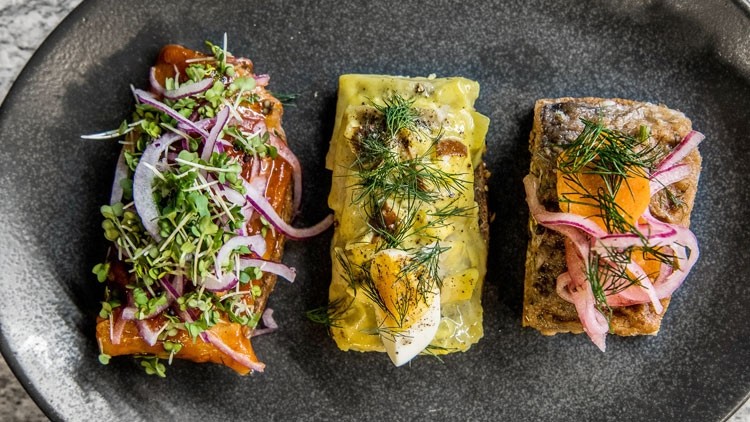Chef Masterclass: Pickled Herrings by Ekte's Robin Freeman

It is the world’s most abundant fish species – shoals have been measured at 4 cubic kilometres, containing an estimated four billion fish – but its movements are unpredictable. As Nilsson remarks: “In years when the shoals were plentiful, people moved to the coast in a sort of gold-fever herring frenzy, and in years when no, or only a few, shoals approached the shore, starvation and misery followed.”
These days, herring is mostly fished further out to sea, then either sold fresh, or salted to preserve it. At Ekte, the new Scandinavian restaurant in Bloomberg Arcade, Swedish-born head chef Robin Freeman uses both versions, frying fresh herrings in rye flour, then pickling them, and pickling salted herrings either as ‘red’ or ‘white’ herrings, then using them in a variety of marinades, to be served with potatoes or as a topping for smörgås – open rye bread sandwiches.
Red herrings have nothing to do with the heavily smoked ‘kippered’ herrings, once popular in Britain. Their colour comes from sandalwood powder which, according to Freeman, “gives the herring a nice floral aroma, as well as colour”.
These are only de-salted for two hours, keeping their flesh firmer than white herrings, which he de-salts for 24 hours and spices simply with bay leaves, allspice and white pepper.
The vinegar used for pickling herring is called attika in Swedish, a spirit vinegar available in a variety of strengths. Ocado sells a 24% version, which means it is 24% acetic acid and 76% water: if a recipe calls for 250ml of attika 12%, you will need to dilute 125ml of attika 24% with the same amount of water. A litre of attika 5% is the equivalent of 210ml of attika 24% with 790ml water, and so on.
“It’s the balance between sugar and vinegar that is vital,” explains Freeman.
“Too much sugar and the fish will go mushy; too much vinegar and they’ll be hard. The classic pickle is called 1-2-3: attika 12%, caster sugar and water, and it’s very common to measure the sugar by volume, as well as the liquids.
“Once you’ve pickled the herrings, they are very versatile: curried herring is very popular, as is tomato herring, but you can experiment. Manufacturers come up with new versions all the time, like crisp flavours. Not all of them work. Lime and chilli? I mean... why would you?”
While herring is abundant in the Atlantic, stocks of Baltic herring (a sub-species, usually smaller and less fatty) have dwindled alarmingly over the past 50 years. The Baltic Sea suffers from hypoxia, a lack of oxygen in its depths, that results from an algal bloom caused by pollution and creates vast ‘dead zones’ on the ocean floor.
Swedes still love strömming (Baltic herring), though, especially as surströmming – herring that has been salted and fermented, then put in tins in which it continues to ferment, producing carbon dioxide and causing the sides of the tins to bulge. It has a reputation as one of the world’s smelliest foods, alongside durian and stinky tofu, and is definitely an acquired taste. As Freeman says: “It’s a completely different kettle of fish.”
Red or white herrings
Ingredients
10 salted herring fillets
1 litre attika 5%
950g caster sugar
4 bay leaves
5 allspice berries
Spices for red herrings
5 cloves
1 cinnamon stick, crumbled
½tbsp red sandalwood powder
(www.justingredients.co.uk)
10 black peppercorns
Spice for white herrings
10 white peppercorns
2 large onions, peeled and sliced
Method:
1. Thoroughly wash the herring fillets, then leave them in cold water for two hours (for red herrings) or 24 hours (for white herrings) and wash again.
2. Heat the vinegar with the sugar and spices, then remove from the heat, add the onions and allow to cool completely before adding the herrings.
Pickled fried herrings
Ingredients:
For the herring:
10 fresh butterflied herring fillets, fins and tail removed, rough bones cut out
150g wholegrain mustard
25g chopped fresh dill
250g rye flour
5g fine sea salt
2g ground white pepper
125g unsalted butter
For the pickle:
750ml water
475g caster sugar
250ml attika 12%
300g red onion, mandolined
300g peeled carrots, mandolined
20g allspice berries
20g white peppercorns
25g chopped fresh dill
5 bay leaves
Method:
1. Heat the water and dissolve the sugar in it. Remove from the heat and add the vinegar, then allow to cool.
2. Trim and clean the herring, Spread 1 tbsp mustard on half of each herring and sprinkle with dill. Mix the rye flour with the salt and pepper. Fold over the herring and coat with flour.
3. Melt butter in a non-stick pan and fry the herring over a medium heat until lightly cooked and golden brown.
4. Put the fried herring into a non-reactive container, cool until lukewarm, then add the rest of the ingredients. Cover with the pickling liquid and transfer to a plastic tub.
5. Leave for at least two hours and serve either warm or at room temperature. Keeps for three to four days in the fridge.
Curried herrings
Ingredients:
900g white herrings
125g mayonnaise
25g set natural yoghurt
70g finely diced Braeburn apples
60g peeled and finely diced celery
15g curry powder (mild or medium)
4g turmeric
Method:
1. Drain the herrings thoroughly and discard the hard spices. Mix the rest of the ingredients thoroughly and layer with the herring in plastic tubs. Leave for at least 24 hours before serving.
Tomato herrings
Ingredients:
900g red herrings
30ml rapeseed oil
120g tomato purée
120ml attika 10%
10ml sherry vinegar
150g caster sugar
35g light brown sugar
90g red onion, sliced on a mandolin
Method:
1. In a saucepan, heat all the ingredients except the herrings and red onion over a medium heat, while stirring. When the sugar has dissolved, remove from the heat and allow to cool completely before adding the herrings and red onions. Leave for 24 hours; keeps for one month.




















